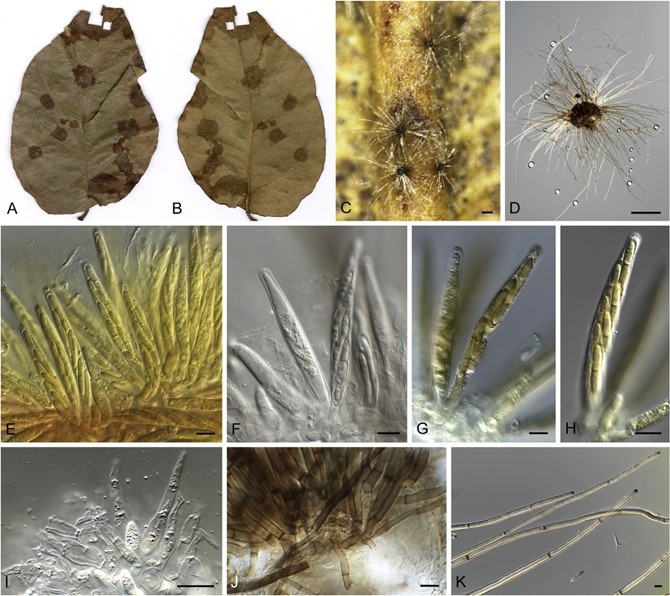Neotrichosphaeria eucalypticola (Sivan. & R.G. Shivas) Crous & Carnegie, in Crous, Wingfield, Cheewangkoon, Carnegie, Burgess, Summerell, Edwards, Taylor, Groenewald, Stud. Mycol. 94: 203 (2019)
Index Fungorum number: IF 832031; MycoBank number: MB 832031; Facesoffungi number: FoF 15069.
Basionym: Trichosphaeria eucalypticola Sivan. & R.G. Shivas, Fungal Diversity 9: 172. 2002.
Leaf spots amphigenous, subcircular, brown, with irregular margins. Mycelium superficial, composed of pale brown, smooth, septate, branched, up to 5 μm thick hyphae. Ascomata perithecial, globose to subglobose with a flattened base and central ostiole, superficial, amphigenous, dark brown, setose, scattered to a few closely grouped, 170–250 μm wide, 150–230 μm high. Setae numerous, pale brown, septate, thick-walled, smooth, up to 600 μm long and 7 μm wide, giving a star-like appearance to the ascoma. Peridium up to 26 μm thick is composed of polygonal to angular, dark brown, thick-walled cells towards the outer side, and subhyaline to hyaline, thin-walled, compressed cells towards the interior. Paraphyses hyaline, septate, deliquescing early. Asci cylindrical to cylindric-clavate to narrowly ellipsoid, short-stalked, unitunicate, 8-spored, 70–95 × 9.5–11 μm, with an amyloid apical structure staining blue in Meltzer’s reagent. Ascospores narrowly ellipsoid to fusoid, hyaline, aseptate, smooth, guttulate when young, mostly straight to slightly curved, obliquely uniseriate to biseriate inside ascus, 16–23 × 4.5–6 μm (adapted from Sivanesan & Shivas 2002b).
Typus – Australia, Queensland, Babinda, on E. deglupta, 6 Jul. 2000, M.H. Ivory (holotype BRIP 27808); New South Wales, Kew, Burrawan State Forest, on E. microcorys, 14 Apr. 2018, A.J. Carnegie, HPC 2416 (epitype designated here CBS H- 24045, MBT388156, culture ex-epitype CBS 145891 = CPC 35777).
Notes – Based on a megablast search of NCBI’s GenBank nucleotide database, the closest hits using the ITS sequence had the highest similarity to Iodosphaeria sp. DSM-2019a voucher MFLU 19-0719 (GenBank MK737501.1; Identities = 505/575 (88 %), 23 gaps (4 %)), and Iodosphaeria tongrenensis (as Iodosphaeria sp. QL-2015 voucher MFLU 15-0393, GenBank KR095282.1; Identities = 444/505 (88 %), 23 gaps (4 %)). Closest hits using the LSU sequence are Iodosphaeria tongrenensis (as Iodosphaeria sp. QL-2015 voucher MFLU 15-0393, GenBank KR095283.1; Identities = 766/780 (98 %), 1 gap (0 %)), Iodosphaeria sp. DSM-2019a voucher MFLU 19-0719 (GenBank MK722172.1; Identities = 764/780 (98 %), 1 gap (0 %)), and Pseudosporidesmium knawiae (GenBank MH874823.1; Identities = 741/782 (95 %), 7 gaps (0 %)).

Fig. 1. Neotrichosphaeria eucalypticola (CBS H-24045). A, B. Disease symptoms (BRIP 27808). C. Ascomata on the leaf midrib. D. Ascoma with setae. E–H. Asci. I. Paraphyses. J, K. Setae. Scale bars = 10 μm.
